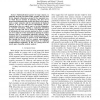Free Online Productivity Tools
i2Speak
i2Symbol
i2OCR
iTex2Img
iWeb2Print
iWeb2Shot
i2Type
iPdf2Split
iPdf2Merge
i2Bopomofo
i2Arabic
i2Style
i2Image
i2PDF
iLatex2Rtf
Sci2ools
ISDA
2010
IEEE
2010
IEEE
Improving statistical parsing by linguistic regularization
Statistically-based parsers for large corpora, in particular the Penn Tree Bank (PTB), typically have not used all the linguistic information encoded in the annotated trees on which they are trained. In particular, they have not in general used information that records the effects of derivations, such as empty categories and the representation of displaced phrases, as is the case with passive, topicalization, and whconstructions. Here we explore ways to use this information to "unwind" derivations, yielding a regularized underlying syntactic structure that can be used as an additional source of information for more accurate parsing. In effect, we make use of two joint sets of tree structures for parsing: the surface structure and its corresponding underlying structure where arguments have been restored to their canonical positions. We present a pilot experiment on passives in the PTB indicating that through the use of these two syntactic representations we can improve overall...
ISDA 2010 | Operating System | Parsing | Possible Syntactic Analyses | Regularized Underlying Syntactic |
| Added | 13 Feb 2011 |
| Updated | 13 Feb 2011 |
| Type | Journal |
| Year | 2010 |
| Where | ISDA |
| Authors | Igor Malioutov, Robert C. Berwick |
Comments (0)

